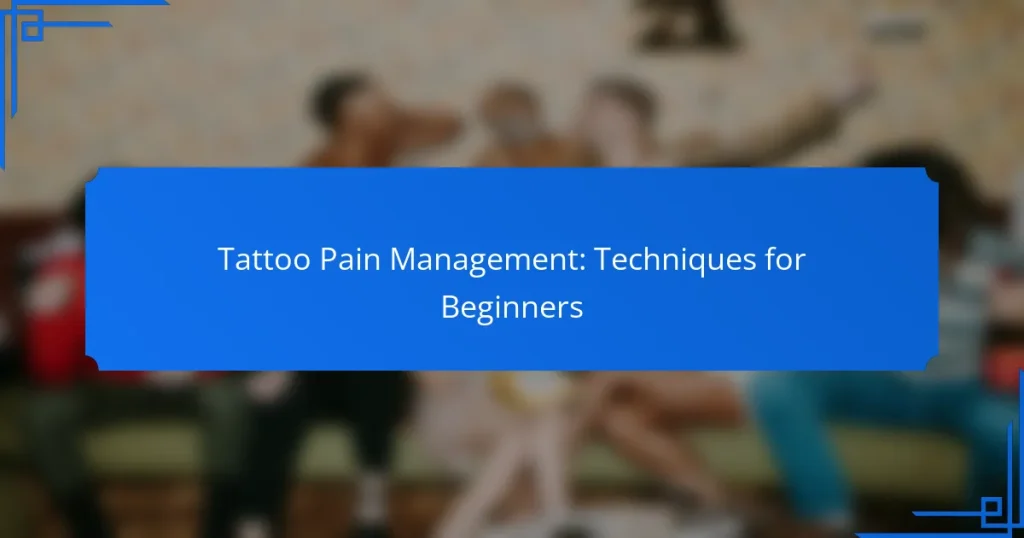Getting a tattoo can be an exciting yet daunting experience, especially for beginners who may be concerned about pain. Understanding effective pain management techniques, such as topical anesthetics, cold therapy, and distraction methods, can make the process more manageable. Additionally, recognizing how the tattoo’s location and individual pain tolerance can affect discomfort levels is crucial for a more comfortable experience.

What Are the Best Tattoo Pain Management Techniques?
The best tattoo pain management techniques include topical anesthetics, cold therapy, distraction methods, breathing techniques, and hydration strategies. Each method can help reduce discomfort during the tattooing process, making it more tolerable for beginners.
Topical anesthetics
Topical anesthetics are creams or gels applied to the skin before tattooing to numb the area. Common options include lidocaine and benzocaine, which can provide significant pain relief for up to several hours. Always follow the product instructions and consult with your tattoo artist to ensure compatibility with the tattooing process.
When using topical anesthetics, apply them at least 30 minutes before your appointment for optimal effectiveness. Be aware that some artists may prefer not to work with clients using these products, so communication is key.
Cold therapy
Cold therapy involves applying ice packs or cold compresses to the tattoo area before and during the session. This method can temporarily numb the skin and reduce swelling, making the experience more comfortable. Aim to apply cold therapy for about 10-15 minutes before starting the tattoo.
While cold therapy is effective, avoid placing ice directly on the skin to prevent frostbite. Instead, wrap ice packs in a cloth or use a gel pack designed for skin contact.
Distraction methods
Distraction methods can help take your mind off the pain during the tattooing process. Listening to music, watching videos, or engaging in conversation with the artist can be effective strategies. Choose activities that you find enjoyable and immersive to help minimize your focus on discomfort.
Consider bringing headphones and a playlist of your favorite songs or a movie to watch on your phone. This can create a more enjoyable atmosphere and help reduce anxiety about the pain.
Breathing techniques
Breathing techniques can significantly help manage pain during a tattoo session. Deep, controlled breathing can promote relaxation and reduce the perception of pain. Practice inhaling deeply through your nose and exhaling slowly through your mouth, focusing on calming your mind and body.
Incorporate breathing exercises before and during the tattooing process. For example, try the 4-7-8 technique: inhale for 4 seconds, hold for 7 seconds, and exhale for 8 seconds. This can help maintain a sense of calm throughout the experience.
Hydration strategies
Staying hydrated before and during your tattoo appointment can help manage pain and improve skin elasticity. Drink plenty of water in the days leading up to your session, and consider having a water bottle on hand during the tattooing process. Proper hydration can also aid in the healing process afterward.
Avoid alcohol and caffeine before your appointment, as these can dehydrate you and potentially increase sensitivity to pain. Aim for a balanced intake of fluids to ensure your body is well-prepared for the tattooing experience.

How Does Location Affect Tattoo Pain?
The location of a tattoo significantly influences the level of pain experienced during the process. Areas with more nerve endings, thinner skin, or proximity to bones tend to be more painful than others.
Areas with more nerve endings
Tattooing over areas rich in nerve endings, such as the ribs, spine, and inner arms, can lead to heightened discomfort. These regions are sensitive due to the concentration of nerve receptors, making the sensation of the needle more intense.
When choosing a tattoo location, consider that areas like the hands and feet are also known for their sensitivity. If you’re concerned about pain, opting for less sensitive areas, such as the upper arm or thigh, may be a better choice.
Skin thickness variations
The thickness of the skin varies across the body, affecting how painful a tattoo may feel. Thinner skin, found on the inner wrist or the face, is generally more sensitive and can lead to increased pain during tattooing.
In contrast, thicker skin areas, such as the outer shoulder or calf, tend to be less painful. Understanding these variations can help you make an informed decision about where to place your tattoo.
Bone proximity
Tattooing near bones can amplify pain due to the lack of cushioning between the skin and the bone. Areas like the elbows, knees, and ankles are particularly sensitive because the needle may directly impact the bone or the tissue surrounding it.
If you are worried about pain, consider avoiding these bony areas or discussing your concerns with your tattoo artist, who may suggest techniques to minimize discomfort in sensitive locations.

What Should Beginners Know About Pain Levels?
Beginners should understand that tattoo pain levels can vary significantly based on several factors, including the body part being tattooed and individual pain tolerance. Generally, pain is often described on a scale from mild discomfort to intense pain, depending on these variables.
Understanding pain scale
The pain scale for tattoos typically ranges from 1 to 10, where 1 represents minimal discomfort and 10 signifies extreme pain. Commonly, areas with more flesh and muscle, like the upper arm, tend to be less painful, while bony areas, such as the ribs or spine, often register higher on the scale.
Artists and clients often use this scale to communicate expectations. For instance, a tattoo on the thigh might be rated around 3-4, while one on the ankle could be rated 7-8. Understanding this scale helps beginners mentally prepare for their tattoo experience.
Individual pain tolerance
Each person’s pain tolerance is unique, influenced by factors such as genetics, mood, and past experiences with pain. Some individuals may find the tattooing process relatively easy, while others may struggle with even mild discomfort.
To gauge your own pain tolerance, consider how you handle other painful situations, such as dental work or injuries. This self-awareness can help set realistic expectations for your tattoo session.
Common misconceptions
One common misconception is that all tattoos are equally painful regardless of location. In reality, the pain can vary significantly based on the area being tattooed and the technique used by the artist.
Another myth is that larger tattoos always hurt more than smaller ones. While size can contribute to overall discomfort, the tattoo’s placement and the individual’s pain threshold are more critical factors. Understanding these misconceptions can help beginners approach their tattoo experience with a clearer mindset.

What Are the Psychological Aspects of Tattoo Pain?
The psychological aspects of tattoo pain significantly influence how individuals experience discomfort during the process. Understanding these factors can help in managing pain more effectively and improving the overall tattoo experience.
Mindset preparation
Preparing your mindset before getting a tattoo can greatly reduce perceived pain. Visualizing a positive outcome and focusing on the art rather than the discomfort can shift your attention away from the pain. Techniques such as meditation or deep breathing exercises can help establish a calm mental state.
Consider discussing your expectations with the tattoo artist, as they can provide insights and reassurance that may ease your mind. Setting realistic expectations about the pain level based on the tattoo’s location can also help you mentally prepare.
Role of anxiety
Anxiety can amplify the sensation of pain during a tattoo session. When you’re anxious, your body may tense up, making the experience feel more intense. Recognizing and addressing anxiety before and during the process is crucial for pain management.
Practicing relaxation techniques, such as progressive muscle relaxation or guided imagery, can help mitigate anxiety. Additionally, bringing a friend for support or engaging in light conversation with the tattoo artist can distract you from anxious thoughts.
Positive reinforcement techniques
Using positive reinforcement can enhance your tattoo experience and help manage pain. Rewarding yourself for completing the session or for enduring specific pain levels can create a more positive association with the process. This could be as simple as treating yourself to a favorite meal or planning a fun activity afterward.
Additionally, focusing on the end result—a beautiful piece of art—can serve as motivation. Reminding yourself of the personal significance of the tattoo can help you endure the discomfort, making the experience feel worthwhile.

How Can Aftercare Help with Pain Management?
Aftercare is crucial for pain management following a tattoo, as it promotes healing and reduces discomfort. Proper aftercare techniques can minimize inflammation and prevent infection, which can exacerbate pain levels during recovery.
Proper wound care
Proper wound care involves keeping the tattooed area clean and moisturized to facilitate healing. Start by gently washing the tattoo with mild soap and lukewarm water, then pat it dry with a clean towel. Avoid scrubbing or using abrasive materials that could irritate the skin.
Applying a thin layer of fragrance-free moisturizer or a specialized tattoo aftercare ointment can help maintain hydration. It’s essential to follow the artist’s recommendations regarding the type of product to use, as some may be more effective than others.
Additionally, avoid exposing the tattoo to direct sunlight or soaking it in water for extended periods, such as in pools or hot tubs, during the initial healing phase. These practices can lead to complications that may increase pain and prolong recovery.


